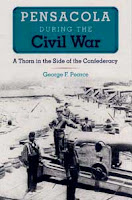 by George F. Pearce
by George F. PearceFrom the publisher:
"A pathbreaking study of one of the forgotten enclaves of the Civil War. . . . [It] opens new understanding of the role of Fort Pickens and Pensacola and the onset of the Civil War." -- B. F. Cooling, author of Forts Henry and Donelson: Key to the Confederate Heartland
Well before the outbreak of the Civil War, both North and South recognized the strategic importance of Pensacola, Florida’s largest city in 1861. Bruce Catton has characterized nearby Fort Pickens, on the northwestern Gulf Coast, as "a case that was fully as explosive as that of Fort Sumter." Until this new work by George Pearce, however, historians have neglected Pensacola’s role in the secession crisis and the conflict that ensued.
This straightforward narrative account begins with the secession movement and the Fort Pickens truce, then follows the course of events in this forgotten corner of the war. From the secessionist capture of Pensacola's navy yard and hospital and Forts Barrancas and McRee in February 1861, to Bragg’s failed raid on Fort Pickens, to the operations of the East and West Gulf Blockading Squadrons creating unrest along the coast, Pearce follows the actions by which the Union denied Confederate resupply by sea and tied down a considerable Confederate force that was increasingly needed elsewhere. He details Union cavalry raids as far north as Alabama, which disrupted vital rail transportation between Mississippi and Georgia, and the defeat of the Confederates at Blakely, which forced the surrender of Mobile.
Pearce also follows the impact of the war on Pensacola itself. Coping with white refugees, freed slaves, scorched-earth evacuations, raiding and foraging by the military, and the constant presence of Union and Confederate troops led to the abandonment of the city. By July 1863, a once vibrant population had dwindled to 72 whites and 10 blacks, and the scars of conflict gave this antebellum metropolis a ghostly appearance.
Illustrated with maps and period photos and drawings, this first examination of Pensacola's forgotten role in the Civil War will appeal to both Civil War buffs and those interested in the history of the Gulf Coast from Pensacola to the Rio Grande.
George F. Pearce, professor emeritus of history at the University of West Florida in Pensacola, is the author of The U.S. Navy in Pensacola: From Sailing Ships to Naval Aviation, 1825-1930 (UPF, 1980).

